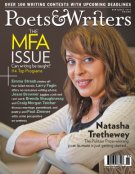Can creative writing be taught? I’ve always hated the question, in part because of its passive construction, which omits both students and teachers. It has always seemed to me to imply some abstract learning scenario wherein a generic would-be writer is acted upon by unnamed forces and thereby caused to understand the obscure codes and formulas of creative writing. There’s actually a name for this approach: Transmission Model Learning, wherein the teacher transmits information to a passive student, who memorizes and regurgitates the material until it is learned. While it used to be the dominant approach to teaching, no one really believes in Transmission Model Learning anymore, certainly not in the arts and humanities. So the question has always seemed to me to promise its own answer: Of course not. Besides, creative writing has no quantifiable body of information, its outcomes are difficult to objectively measure, it involves too much chatter and sitting around in bars and coffee houses, and anyway, real artists are born artists—people whose genius shouldn’t be corrupted by instruction. Right?
Even before I started down the road of becoming a full-time teacher of creative writing in an MFA program, before I’d entered a graduate fiction writing workshop and heard the late Frank Conroy’s staple first-day lecture on Occam’s razor, abject naturalism, the meaning-sense-and-clarity pyramid, and a long rant that included chalkboard diagrams with stick figures, coal bins, and something reminiscent of broken rainbows, during which he adamantly debunked not Transmission Model Learning but rather Transmission Model Reading (“It’s a dance! The reader is not a passive blank slate, reading-and-writing is always a collaborative endeavor!”), I knew writing was something I wanted to do—and that I could be taught how to do it better. I didn’t know how I’d learn it, much less how I’d one day teach it; I only knew that I wanted to be in the classroom, and that something about the whole endeavor was electrifying.
I’d spent most of my adult life to that point playing and teaching violin for a living. I had some faith that, if I could learn to do that, then I could learn about writing and I could learn to teach it. Musicians and music teachers don’t spend a lot of time questioning whether or not their instruments can be taught. We take it for granted and share what worked for us as learners. We invent or research new techniques and approaches as students come to us with problems we don’t recognize, and we adjust the pace according to the student’s abilities and drive. Some of us are better or worse at this than others. Frankly, I don’t think I ever got to be very good at it. But when I was teaching music close to full-time, the question was never, Can this be done? The question was always, Why are some students so much better and faster at learning? Why do some of them have willpower and discipline and others don’t? All my students, if they applied themselves, could absolutely improve, but the ones with discipline and talent, the ones who practiced, could go faster and further.
After fifteen years of teaching creative writing full-time, I’m pretty sure the question for writing teachers is, or should be, basically the same. It’s not, Can it be taught? Of course it can be taught. Anyone who’s sat in an effective workshop can tell you that. The question is, Why does it work when it works? When it works especially well, what’s happening?
In order to answer, we have to make the original question active by returning to its true subject and object—student and teacher.








